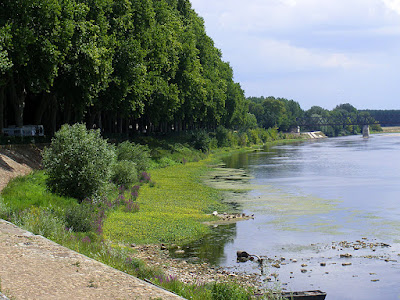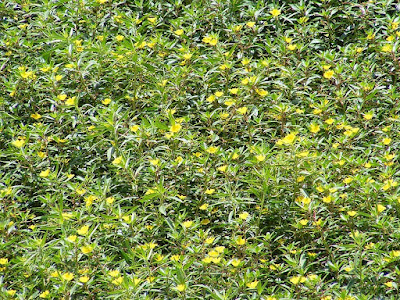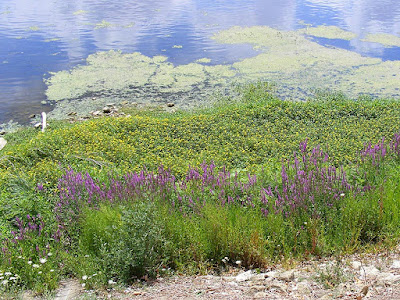It is a rooting aquatic plant with alternate leaves and yellow flowers 2-5 cm across, which come from the leaf axils. It flowers from June to September. The plant is very variable, with several forms possible.
Jussie growing along the shore of the Vienne river in Chinon, on a bend between two bridges (below). A typical site to find the plant, where the water is slow.
 Jussie likes stagnant or slow moving water (étangs, marshes, irrigation canals, water courses, wetlands) and grows best in full sun. Plants can develop in up to 3m depth of water and sit up to 80 cm above the surface of the water. The principal mechanism of reproduction is by cuttings - the smallest fragment will create a new plant, resulting in a carpet of vegetation. They first appear in the shallows, but soon move out to the centre of a body of water, choking out the native yellow waterlilies and water knotweed and interfering with the activities of wild animals.
Jussie likes stagnant or slow moving water (étangs, marshes, irrigation canals, water courses, wetlands) and grows best in full sun. Plants can develop in up to 3m depth of water and sit up to 80 cm above the surface of the water. The principal mechanism of reproduction is by cuttings - the smallest fragment will create a new plant, resulting in a carpet of vegetation. They first appear in the shallows, but soon move out to the centre of a body of water, choking out the native yellow waterlilies and water knotweed and interfering with the activities of wild animals.A thick blanket of Jussie.
 This means that handling the plant in any way can create new colonies, which poses a real danger for aquatic and wetland habitats. There are both economic and ecological consequences.
This means that handling the plant in any way can create new colonies, which poses a real danger for aquatic and wetland habitats. There are both economic and ecological consequences.- It can harm certain species of fish by depriving them of food and egglaying sites.
- It accelerates the process of siltification with its accumulation of organic material and by trapping material in suspension.
- It disturbs other animal species such as waterfowl, depriving them of retreats and nesting places.
- It alters the quality of the water.
- By its rapid takeover it supplants other aquatic and semi-aquatic plant species, causing them to disappear in a few months!
- It renders some activities difficult or near enough impossible eg. fishing, boating, hunting waterfowl.
- Owners and managers of ponds - prevent the propagation of plants when draining by placing filters or nets over the drain. Not to do so risks a rapid colonisation downstream in water courses or other connected ponds. You must also meticulously clean your equipment (nets, boots, etc).
- Aquarium owners - when cleaning your aquarium put all plants and rubbish in a sealed bag before throwing it in the garbage bin.
- Fishermen and walkers - don't cut, transplant or trim it. Any handling of the plant contributes to its propagation.
A pretty picture, but a problem plant.
 The authorities are considering three ways of fighting this beautiful but problematic plant:
The authorities are considering three ways of fighting this beautiful but problematic plant:- Mechanical weeding - used to re-open very densely covered areas. The effect is immediate, but must be finished manually and the work must be maintained to limit the return of the Jussie. Everything must be carefully controlled to prevent cuttings from re-establishing themselves.
- Hand weeding - effective and advantageous for small surfaces or ecologically sensitive sites. The weeding must start the moment the first plants appear. Every single fragment of plant must be removed off the site. This technique can be used on its own or to maintain control following mechanical weeding.
- Herbicides - these substances, even if approved, can impact very strongly on an aquatic habitat. Their use is not recommended.
DON'T use techniques that break the plant up and thus help to propagate it eg. strimming.
DO act quickly, as soon as possible, when the first plants appear. If you wait it will be too late.
Susan

1 comment:
This plant is choking the little pond out behind our house. I think it was brought to the pond during the drought of 2003 when the town trucked water up from the river. It's a shame, because we used to have ducks on the pond. Now the fish and frogs are having a tough time of it. There's only a small area of the surface clear, and who knows how long that will last?
Post a Comment